Project Management in Business: Phases, Tools, and Stakeholders Report
VerifiedAdded on 2023/01/20
|13
|2912
|36
Report
AI Summary
This report provides a comprehensive overview of project management within the context of business. It begins by defining a project and its characteristics, differentiating between strategic and operational projects. The report then delves into the key phases of project management, including project initiation, planning, execution, monitoring and control, and closure, explaining each phase in detail. Furthermore, it identifies and describes various tools used in project management, such as network diagrams, the critical path method, Gantt charts, and work breakdown structures, highlighting their applications. Finally, the report examines project stakeholders, categorizing them as internal and external, and discusses their significance. The reflection section showcases the student's learning journey, emphasizing the development of skills like communication, problem-solving, and ICT proficiency through the module and its practical application in understanding project management, particularly in IT implementation.

Foundations of Business Management
1
1
Paraphrase This Document
Need a fresh take? Get an instant paraphrase of this document with our AI Paraphraser
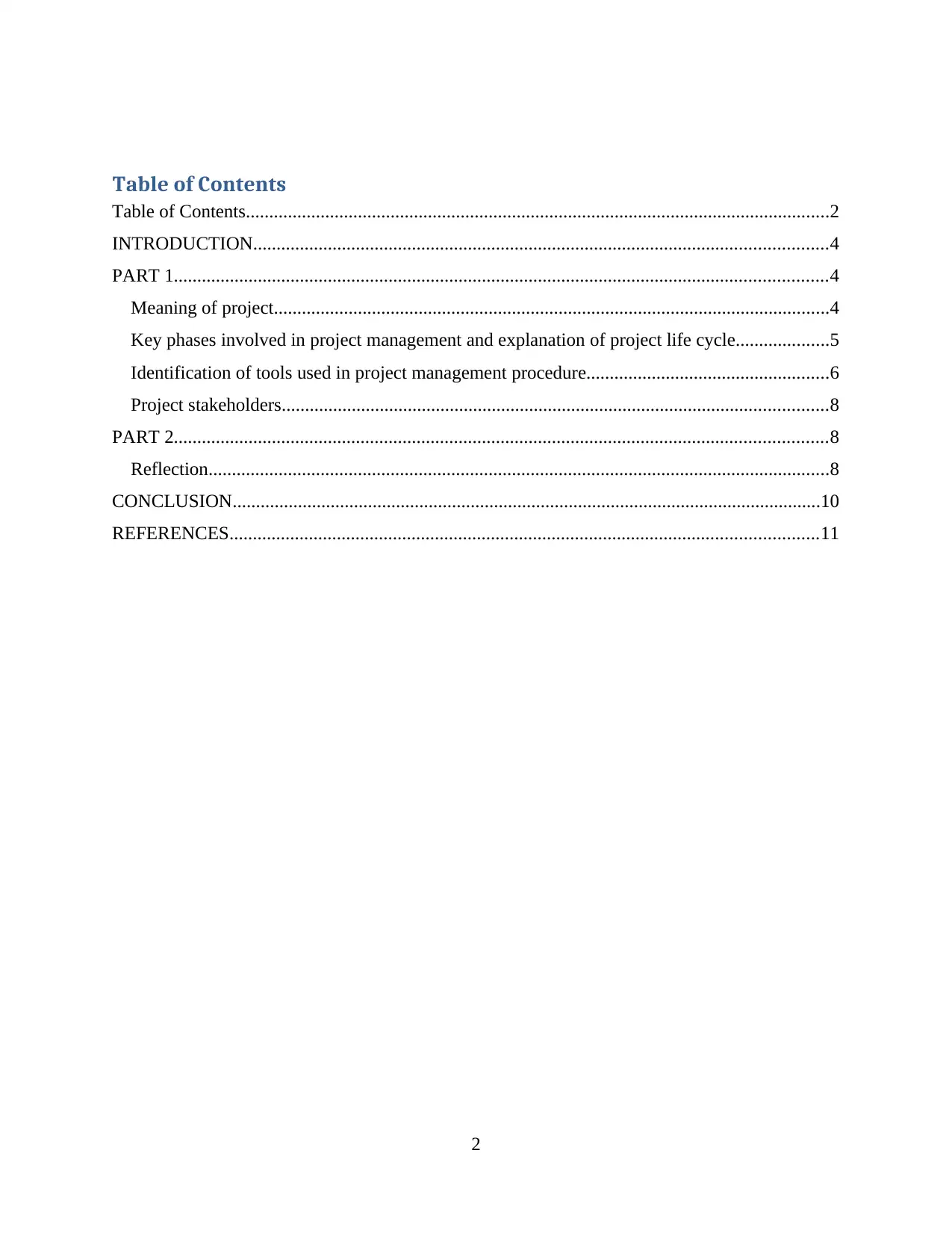
Table of Contents
Table of Contents.............................................................................................................................2
INTRODUCTION...........................................................................................................................4
PART 1............................................................................................................................................4
Meaning of project.......................................................................................................................4
Key phases involved in project management and explanation of project life cycle....................5
Identification of tools used in project management procedure....................................................6
Project stakeholders.....................................................................................................................8
PART 2............................................................................................................................................8
Reflection.....................................................................................................................................8
CONCLUSION..............................................................................................................................10
REFERENCES..............................................................................................................................11
2
Table of Contents.............................................................................................................................2
INTRODUCTION...........................................................................................................................4
PART 1............................................................................................................................................4
Meaning of project.......................................................................................................................4
Key phases involved in project management and explanation of project life cycle....................5
Identification of tools used in project management procedure....................................................6
Project stakeholders.....................................................................................................................8
PART 2............................................................................................................................................8
Reflection.....................................................................................................................................8
CONCLUSION..............................................................................................................................10
REFERENCES..............................................................................................................................11
2

3
⊘ This is a preview!⊘
Do you want full access?
Subscribe today to unlock all pages.

Trusted by 1+ million students worldwide
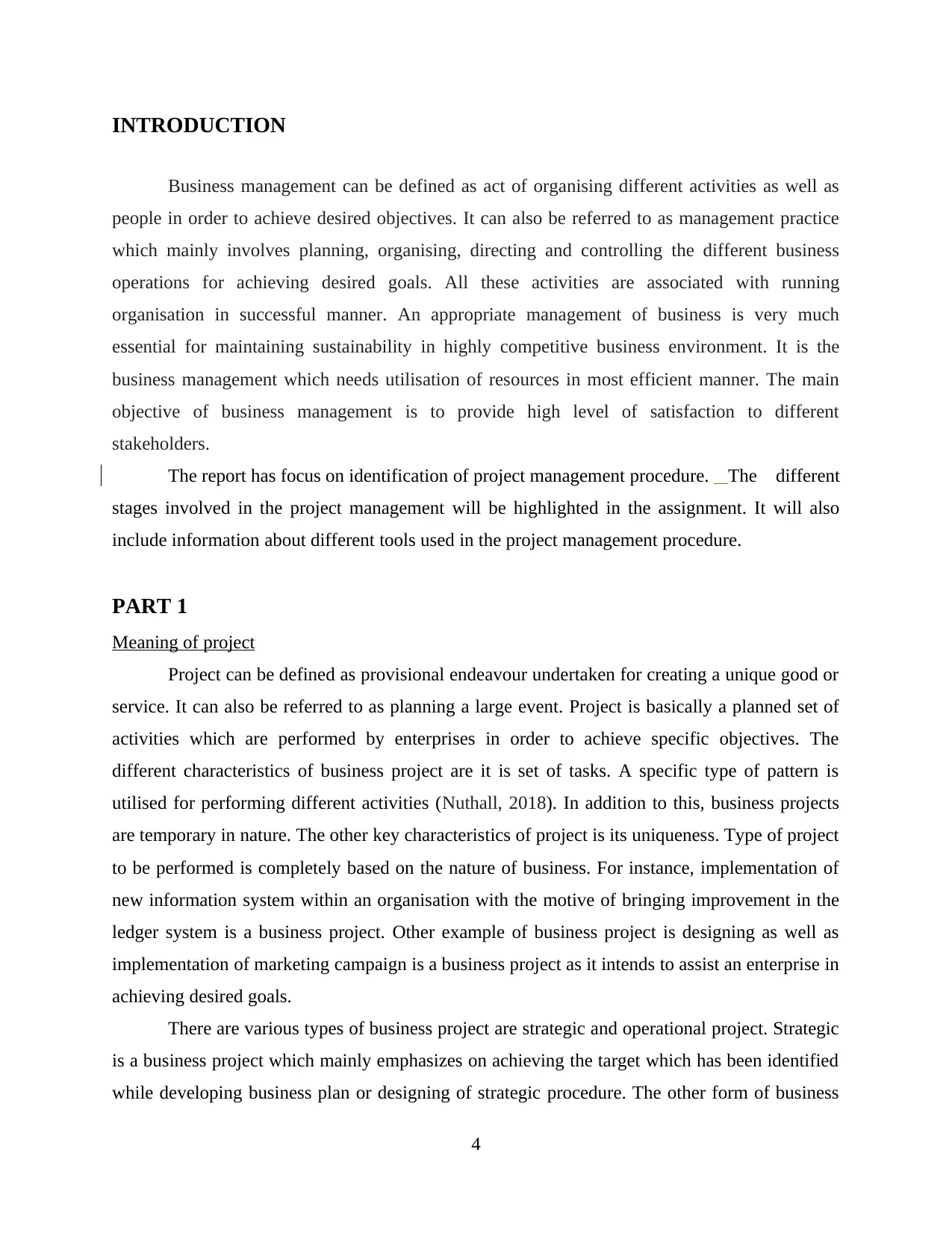
INTRODUCTION
Business management can be defined as act of organising different activities as well as
people in order to achieve desired objectives. It can also be referred to as management practice
which mainly involves planning, organising, directing and controlling the different business
operations for achieving desired goals. All these activities are associated with running
organisation in successful manner. An appropriate management of business is very much
essential for maintaining sustainability in highly competitive business environment. It is the
business management which needs utilisation of resources in most efficient manner. The main
objective of business management is to provide high level of satisfaction to different
stakeholders.
The report has focus on identification of project management procedure. The different
stages involved in the project management will be highlighted in the assignment. It will also
include information about different tools used in the project management procedure.
PART 1
Meaning of project
Project can be defined as provisional endeavour undertaken for creating a unique good or
service. It can also be referred to as planning a large event. Project is basically a planned set of
activities which are performed by enterprises in order to achieve specific objectives. The
different characteristics of business project are it is set of tasks. A specific type of pattern is
utilised for performing different activities (Nuthall, 2018). In addition to this, business projects
are temporary in nature. The other key characteristics of project is its uniqueness. Type of project
to be performed is completely based on the nature of business. For instance, implementation of
new information system within an organisation with the motive of bringing improvement in the
ledger system is a business project. Other example of business project is designing as well as
implementation of marketing campaign is a business project as it intends to assist an enterprise in
achieving desired goals.
There are various types of business project are strategic and operational project. Strategic
is a business project which mainly emphasizes on achieving the target which has been identified
while developing business plan or designing of strategic procedure. The other form of business
4
Business management can be defined as act of organising different activities as well as
people in order to achieve desired objectives. It can also be referred to as management practice
which mainly involves planning, organising, directing and controlling the different business
operations for achieving desired goals. All these activities are associated with running
organisation in successful manner. An appropriate management of business is very much
essential for maintaining sustainability in highly competitive business environment. It is the
business management which needs utilisation of resources in most efficient manner. The main
objective of business management is to provide high level of satisfaction to different
stakeholders.
The report has focus on identification of project management procedure. The different
stages involved in the project management will be highlighted in the assignment. It will also
include information about different tools used in the project management procedure.
PART 1
Meaning of project
Project can be defined as provisional endeavour undertaken for creating a unique good or
service. It can also be referred to as planning a large event. Project is basically a planned set of
activities which are performed by enterprises in order to achieve specific objectives. The
different characteristics of business project are it is set of tasks. A specific type of pattern is
utilised for performing different activities (Nuthall, 2018). In addition to this, business projects
are temporary in nature. The other key characteristics of project is its uniqueness. Type of project
to be performed is completely based on the nature of business. For instance, implementation of
new information system within an organisation with the motive of bringing improvement in the
ledger system is a business project. Other example of business project is designing as well as
implementation of marketing campaign is a business project as it intends to assist an enterprise in
achieving desired goals.
There are various types of business project are strategic and operational project. Strategic
is a business project which mainly emphasizes on achieving the target which has been identified
while developing business plan or designing of strategic procedure. The other form of business
4
Paraphrase This Document
Need a fresh take? Get an instant paraphrase of this document with our AI Paraphraser
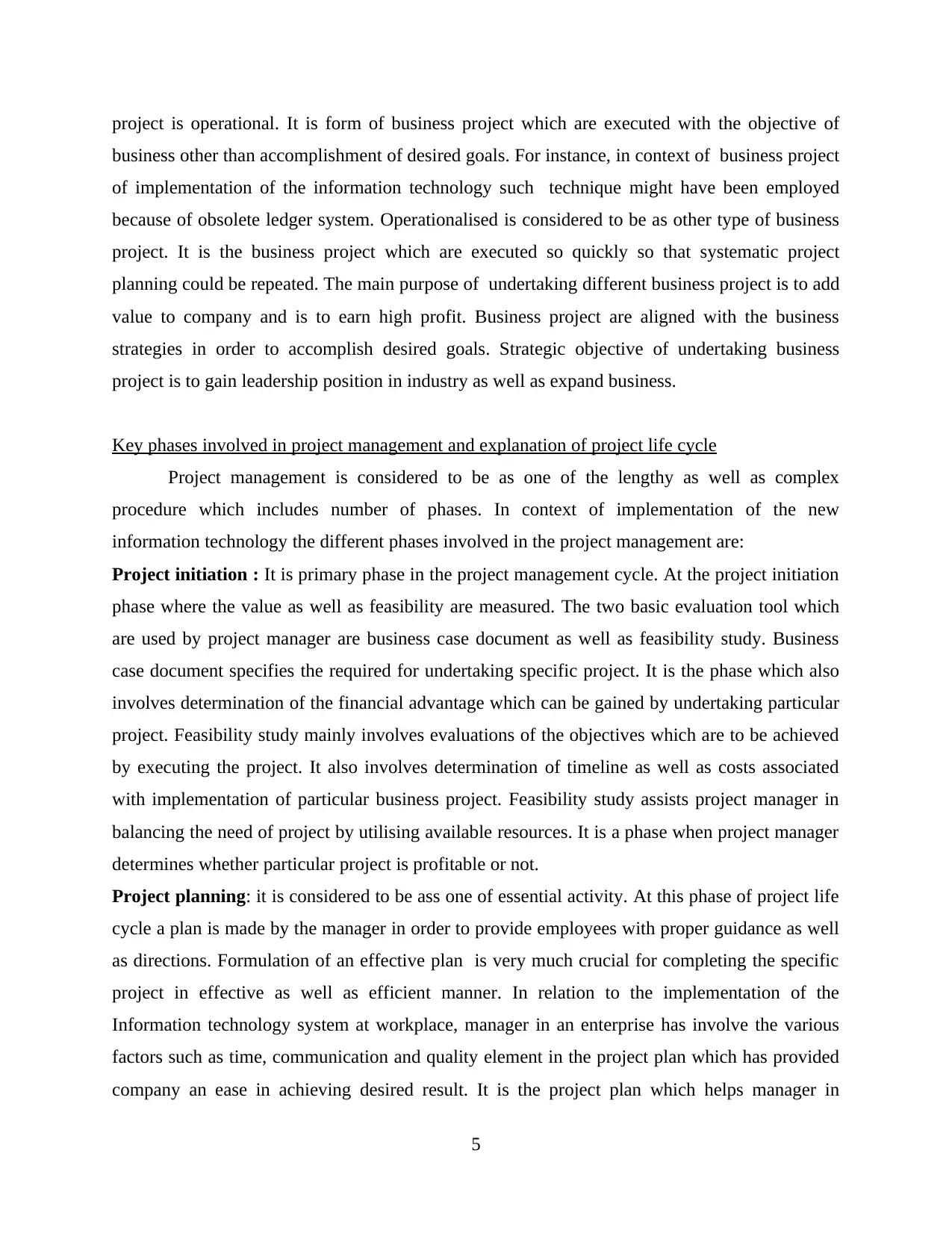
project is operational. It is form of business project which are executed with the objective of
business other than accomplishment of desired goals. For instance, in context of business project
of implementation of the information technology such technique might have been employed
because of obsolete ledger system. Operationalised is considered to be as other type of business
project. It is the business project which are executed so quickly so that systematic project
planning could be repeated. The main purpose of undertaking different business project is to add
value to company and is to earn high profit. Business project are aligned with the business
strategies in order to accomplish desired goals. Strategic objective of undertaking business
project is to gain leadership position in industry as well as expand business.
Key phases involved in project management and explanation of project life cycle
Project management is considered to be as one of the lengthy as well as complex
procedure which includes number of phases. In context of implementation of the new
information technology the different phases involved in the project management are:
Project initiation : It is primary phase in the project management cycle. At the project initiation
phase where the value as well as feasibility are measured. The two basic evaluation tool which
are used by project manager are business case document as well as feasibility study. Business
case document specifies the required for undertaking specific project. It is the phase which also
involves determination of the financial advantage which can be gained by undertaking particular
project. Feasibility study mainly involves evaluations of the objectives which are to be achieved
by executing the project. It also involves determination of timeline as well as costs associated
with implementation of particular business project. Feasibility study assists project manager in
balancing the need of project by utilising available resources. It is a phase when project manager
determines whether particular project is profitable or not.
Project planning: it is considered to be ass one of essential activity. At this phase of project life
cycle a plan is made by the manager in order to provide employees with proper guidance as well
as directions. Formulation of an effective plan is very much crucial for completing the specific
project in effective as well as efficient manner. In relation to the implementation of the
Information technology system at workplace, manager in an enterprise has involve the various
factors such as time, communication and quality element in the project plan which has provided
company an ease in achieving desired result. It is the project plan which helps manager in
5
business other than accomplishment of desired goals. For instance, in context of business project
of implementation of the information technology such technique might have been employed
because of obsolete ledger system. Operationalised is considered to be as other type of business
project. It is the business project which are executed so quickly so that systematic project
planning could be repeated. The main purpose of undertaking different business project is to add
value to company and is to earn high profit. Business project are aligned with the business
strategies in order to accomplish desired goals. Strategic objective of undertaking business
project is to gain leadership position in industry as well as expand business.
Key phases involved in project management and explanation of project life cycle
Project management is considered to be as one of the lengthy as well as complex
procedure which includes number of phases. In context of implementation of the new
information technology the different phases involved in the project management are:
Project initiation : It is primary phase in the project management cycle. At the project initiation
phase where the value as well as feasibility are measured. The two basic evaluation tool which
are used by project manager are business case document as well as feasibility study. Business
case document specifies the required for undertaking specific project. It is the phase which also
involves determination of the financial advantage which can be gained by undertaking particular
project. Feasibility study mainly involves evaluations of the objectives which are to be achieved
by executing the project. It also involves determination of timeline as well as costs associated
with implementation of particular business project. Feasibility study assists project manager in
balancing the need of project by utilising available resources. It is a phase when project manager
determines whether particular project is profitable or not.
Project planning: it is considered to be ass one of essential activity. At this phase of project life
cycle a plan is made by the manager in order to provide employees with proper guidance as well
as directions. Formulation of an effective plan is very much crucial for completing the specific
project in effective as well as efficient manner. In relation to the implementation of the
Information technology system at workplace, manager in an enterprise has involve the various
factors such as time, communication and quality element in the project plan which has provided
company an ease in achieving desired result. It is the project plan which helps manager in
5

identifying the obstacles or different risks which might occur in execution of particular project.
The other components of project plan are cost, time frame and scope.
Project execution : It is the phase in the project life cycle which is directly related to the project
management. This phase mainly involves creating deliverables in order to provide client with
high level of satisfaction. Project execution is the phase in the project life cycle where role of
leader is to distribute resources and to make sure that their followers are concentrating on the
different functions which are assigned to them. It is the activity which is highly dependent on the
project planning stage (Vom Brocke and Mendling, 2018). At the project implementation stage,
all the roles as well as responsibilities are performed by different stakeholders according to the
set plan.
Project monitoring and control: This phase in the project life cycle is associated with the
evaluation of result generated after undertaking specific project. It is the activity which can be
performed at the project implementation phase also. At this stage in project life cycle project
manager or leader in an organisation is required to monitor the progress of the different tasks at
regular interval of time, as it will assist them in generation of desired results. Continuous
monitoring helps in guaranteeing a delivery of promise. Monitoring of the activities is also very
much essential in order to prevent or eliminate scope creep. It is the continuous monitoring
strategy which assist manager in analysing the variances. Continuous monitoring assist in
execution of project in smooth manner.
Project closure: it is the last phase in the project life cycle. At this phase project is closed when
the goals are achieved. At this stage, project manager inform all the stakeholder about closure of
project. In addition to this, all the resources are released in order to undertake other project of
similar or different type (Kerzner,2018. ). Project closure is considered to be as one of most
important phases in project life cycle which enables people engaged in project to evaluate as well
as document project.
Identification of tools used in project management procedure.
The tools plays very important role in project management. It is the tool which provides
project manager an ease in managing the project. An appropriate selection of tool is very much
crucial for successful application of different techniques used for managing project. In relation to
the implementation of information technology, the different tools that can be utilised for
managing the project are:
6
The other components of project plan are cost, time frame and scope.
Project execution : It is the phase in the project life cycle which is directly related to the project
management. This phase mainly involves creating deliverables in order to provide client with
high level of satisfaction. Project execution is the phase in the project life cycle where role of
leader is to distribute resources and to make sure that their followers are concentrating on the
different functions which are assigned to them. It is the activity which is highly dependent on the
project planning stage (Vom Brocke and Mendling, 2018). At the project implementation stage,
all the roles as well as responsibilities are performed by different stakeholders according to the
set plan.
Project monitoring and control: This phase in the project life cycle is associated with the
evaluation of result generated after undertaking specific project. It is the activity which can be
performed at the project implementation phase also. At this stage in project life cycle project
manager or leader in an organisation is required to monitor the progress of the different tasks at
regular interval of time, as it will assist them in generation of desired results. Continuous
monitoring helps in guaranteeing a delivery of promise. Monitoring of the activities is also very
much essential in order to prevent or eliminate scope creep. It is the continuous monitoring
strategy which assist manager in analysing the variances. Continuous monitoring assist in
execution of project in smooth manner.
Project closure: it is the last phase in the project life cycle. At this phase project is closed when
the goals are achieved. At this stage, project manager inform all the stakeholder about closure of
project. In addition to this, all the resources are released in order to undertake other project of
similar or different type (Kerzner,2018. ). Project closure is considered to be as one of most
important phases in project life cycle which enables people engaged in project to evaluate as well
as document project.
Identification of tools used in project management procedure.
The tools plays very important role in project management. It is the tool which provides
project manager an ease in managing the project. An appropriate selection of tool is very much
crucial for successful application of different techniques used for managing project. In relation to
the implementation of information technology, the different tools that can be utilised for
managing the project are:
6
⊘ This is a preview!⊘
Do you want full access?
Subscribe today to unlock all pages.

Trusted by 1+ million students worldwide

Network diagram: it is project management tool which is utilised by project manager for the
purpose of planning. Arrows in network diagram represents the interconnected tasks as well as
indicates precedence and interdependencies between activities of a project. Network diagram is
utilised by project manager for computing the duration of project.
Critical path method: It is considered to be as one of the crucial project planning tool which is
utilised by project manager for monitoring progress of the different tasks in the project. It is the
project management tool which provides manager an ease in making sure that project will be
completed on time (Kliem and Ludin, 2019. ). Critical path for the project is considered to be as
longest sequence of different tasks on the network diagram. It is characterised by zero slack of
tasks on the sequence. This statement means that a little time lag in single task on the critical
path will lead to the delay in completion of the whole project. In context of implementation of
the Information technology at workplace project manager need to closely monitor the tasks on
the critical path.
Gantt chart: It is basically a graphical representation of schedule according to which different
tasks are to be performed. Gantt chart is considered to be as an appropriate tool for monitoring as
well as controlling the project. It can be helpful in recording the progress of different tasks
during the project. Gantt chart is considered to be as a good project planning tool as it specifies
the scheduler of project as bar charts spread out over a timeline. The progress of every task is
specified with different colour from the strategic duration of the task. The variance in colours
and the length of the bar chart supports project managers in identifying time lag or schedule
overruns in the project.
Work breakdown structure: it is basically a delivery oriented hierarchical decomposition of
complex task. Work breakdown structure is planning tool which is generally utilised by project
manager for defining the scope. It also helps in identification of different deliverables for the
project (Rendon and Snider, 2019. ). It helps in identification of the detailed deliverables which
assist different stakeholders in developing the understanding about scope of the project. Work
break down structure is used by the project manager for categorising the complex tasks into
manageable tasks. The work breakdown structure also provide manager an ease in planning,
tracking as well as managing project.
7
purpose of planning. Arrows in network diagram represents the interconnected tasks as well as
indicates precedence and interdependencies between activities of a project. Network diagram is
utilised by project manager for computing the duration of project.
Critical path method: It is considered to be as one of the crucial project planning tool which is
utilised by project manager for monitoring progress of the different tasks in the project. It is the
project management tool which provides manager an ease in making sure that project will be
completed on time (Kliem and Ludin, 2019. ). Critical path for the project is considered to be as
longest sequence of different tasks on the network diagram. It is characterised by zero slack of
tasks on the sequence. This statement means that a little time lag in single task on the critical
path will lead to the delay in completion of the whole project. In context of implementation of
the Information technology at workplace project manager need to closely monitor the tasks on
the critical path.
Gantt chart: It is basically a graphical representation of schedule according to which different
tasks are to be performed. Gantt chart is considered to be as an appropriate tool for monitoring as
well as controlling the project. It can be helpful in recording the progress of different tasks
during the project. Gantt chart is considered to be as a good project planning tool as it specifies
the scheduler of project as bar charts spread out over a timeline. The progress of every task is
specified with different colour from the strategic duration of the task. The variance in colours
and the length of the bar chart supports project managers in identifying time lag or schedule
overruns in the project.
Work breakdown structure: it is basically a delivery oriented hierarchical decomposition of
complex task. Work breakdown structure is planning tool which is generally utilised by project
manager for defining the scope. It also helps in identification of different deliverables for the
project (Rendon and Snider, 2019. ). It helps in identification of the detailed deliverables which
assist different stakeholders in developing the understanding about scope of the project. Work
break down structure is used by the project manager for categorising the complex tasks into
manageable tasks. The work breakdown structure also provide manager an ease in planning,
tracking as well as managing project.
7
Paraphrase This Document
Need a fresh take? Get an instant paraphrase of this document with our AI Paraphraser

‘
Project stakeholders
Stakeholders are those people who have interest in the project. There are basically two
type of stakeholders these are internal as well as external stakeholder. In relation to the
implementation of information technology business project important stakeholders are top
management, project team, resource manager, customers, government etc.
8
Project stakeholders
Stakeholders are those people who have interest in the project. There are basically two
type of stakeholders these are internal as well as external stakeholder. In relation to the
implementation of information technology business project important stakeholders are top
management, project team, resource manager, customers, government etc.
8

9
⊘ This is a preview!⊘
Do you want full access?
Subscribe today to unlock all pages.

Trusted by 1+ million students worldwide
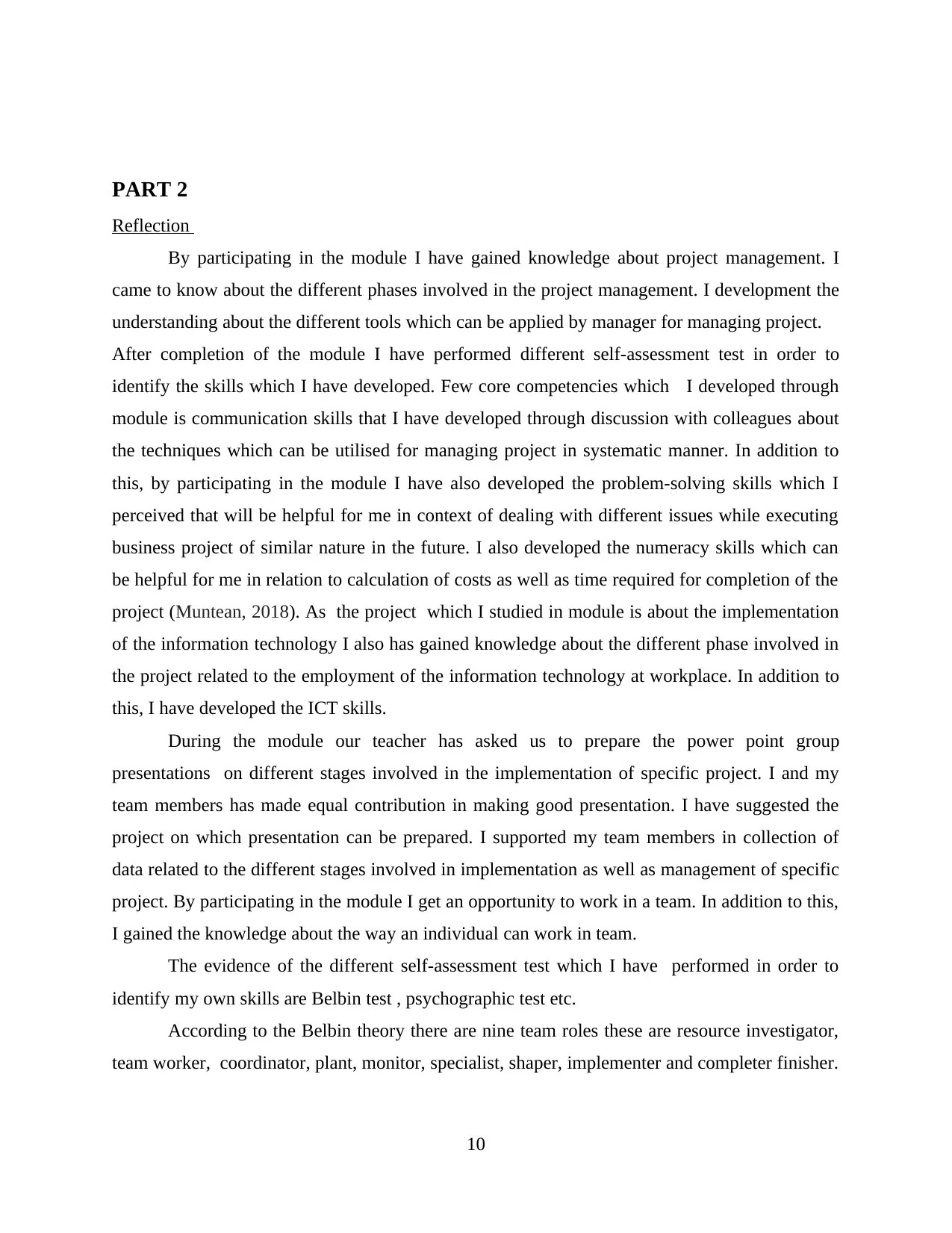
PART 2
Reflection
By participating in the module I have gained knowledge about project management. I
came to know about the different phases involved in the project management. I development the
understanding about the different tools which can be applied by manager for managing project.
After completion of the module I have performed different self-assessment test in order to
identify the skills which I have developed. Few core competencies which I developed through
module is communication skills that I have developed through discussion with colleagues about
the techniques which can be utilised for managing project in systematic manner. In addition to
this, by participating in the module I have also developed the problem-solving skills which I
perceived that will be helpful for me in context of dealing with different issues while executing
business project of similar nature in the future. I also developed the numeracy skills which can
be helpful for me in relation to calculation of costs as well as time required for completion of the
project (Muntean, 2018). As the project which I studied in module is about the implementation
of the information technology I also has gained knowledge about the different phase involved in
the project related to the employment of the information technology at workplace. In addition to
this, I have developed the ICT skills.
During the module our teacher has asked us to prepare the power point group
presentations on different stages involved in the implementation of specific project. I and my
team members has made equal contribution in making good presentation. I have suggested the
project on which presentation can be prepared. I supported my team members in collection of
data related to the different stages involved in implementation as well as management of specific
project. By participating in the module I get an opportunity to work in a team. In addition to this,
I gained the knowledge about the way an individual can work in team.
The evidence of the different self-assessment test which I have performed in order to
identify my own skills are Belbin test , psychographic test etc.
According to the Belbin theory there are nine team roles these are resource investigator,
team worker, coordinator, plant, monitor, specialist, shaper, implementer and completer finisher.
10
Reflection
By participating in the module I have gained knowledge about project management. I
came to know about the different phases involved in the project management. I development the
understanding about the different tools which can be applied by manager for managing project.
After completion of the module I have performed different self-assessment test in order to
identify the skills which I have developed. Few core competencies which I developed through
module is communication skills that I have developed through discussion with colleagues about
the techniques which can be utilised for managing project in systematic manner. In addition to
this, by participating in the module I have also developed the problem-solving skills which I
perceived that will be helpful for me in context of dealing with different issues while executing
business project of similar nature in the future. I also developed the numeracy skills which can
be helpful for me in relation to calculation of costs as well as time required for completion of the
project (Muntean, 2018). As the project which I studied in module is about the implementation
of the information technology I also has gained knowledge about the different phase involved in
the project related to the employment of the information technology at workplace. In addition to
this, I have developed the ICT skills.
During the module our teacher has asked us to prepare the power point group
presentations on different stages involved in the implementation of specific project. I and my
team members has made equal contribution in making good presentation. I have suggested the
project on which presentation can be prepared. I supported my team members in collection of
data related to the different stages involved in implementation as well as management of specific
project. By participating in the module I get an opportunity to work in a team. In addition to this,
I gained the knowledge about the way an individual can work in team.
The evidence of the different self-assessment test which I have performed in order to
identify my own skills are Belbin test , psychographic test etc.
According to the Belbin theory there are nine team roles these are resource investigator,
team worker, coordinator, plant, monitor, specialist, shaper, implementer and completer finisher.
10
Paraphrase This Document
Need a fresh take? Get an instant paraphrase of this document with our AI Paraphraser

As per the Belbin team role theory, the resource investigator utilises their inquisite nature
for identifying ideas for improving team performance. Team workers assist the team in
completion of the project. In addition to this, coordinator emphasizes on team objectives. The
role of coordinator is to delegate work in an appropriate manner. Function of plant in a team is to
resolve the different issues faced by the team members in performing their respective roles as
well as responsibilities. Role of monitor as well as evaluator is to make impartial decisions
considering the interest of all stakeholders involved in the project. Specialist bring in depth
knowledge about key areas to the team. As per Belbin theory role of shaper is to male sure that
all the members in a team are concentrating on their work. It is the duty of implementer to
formulate an effective strategy for completion of specific project in an effective as well as
efficient manner (Tongur,2018). Role of complete finisher in a team is to close the project in
systematic manner after completion of the project.
After performing the Belbin team role test I found that when I involved in a project with
other people I am quite keen to identify latest ideas as well as development. In addition to this ,
before making any decision I analyse the opinion of other people and consider the advantage as
well as disadvantage of the same. According to section B in the Belbin test I assist my colleagues
in resolving the various issues faced by them in completion of the work. In addition to this , I
tend to have creative approach for solving problem. In context of Section C in Belbin test after
completion of the test I found that I have ability coordinate as well as utilise productively other
people potential .
SH CO PL RI ME IMP TW
A 3 7 4 6 5 1 8
B 1 5 5 8 4 7 2
C 7 4 6 2 3 8 1
After analysing the result of Belbin test I found that I need to explore ideas which has wide
application for that I will perform more research and will attend seminars .
11
for identifying ideas for improving team performance. Team workers assist the team in
completion of the project. In addition to this, coordinator emphasizes on team objectives. The
role of coordinator is to delegate work in an appropriate manner. Function of plant in a team is to
resolve the different issues faced by the team members in performing their respective roles as
well as responsibilities. Role of monitor as well as evaluator is to make impartial decisions
considering the interest of all stakeholders involved in the project. Specialist bring in depth
knowledge about key areas to the team. As per Belbin theory role of shaper is to male sure that
all the members in a team are concentrating on their work. It is the duty of implementer to
formulate an effective strategy for completion of specific project in an effective as well as
efficient manner (Tongur,2018). Role of complete finisher in a team is to close the project in
systematic manner after completion of the project.
After performing the Belbin team role test I found that when I involved in a project with
other people I am quite keen to identify latest ideas as well as development. In addition to this ,
before making any decision I analyse the opinion of other people and consider the advantage as
well as disadvantage of the same. According to section B in the Belbin test I assist my colleagues
in resolving the various issues faced by them in completion of the work. In addition to this , I
tend to have creative approach for solving problem. In context of Section C in Belbin test after
completion of the test I found that I have ability coordinate as well as utilise productively other
people potential .
SH CO PL RI ME IMP TW
A 3 7 4 6 5 1 8
B 1 5 5 8 4 7 2
C 7 4 6 2 3 8 1
After analysing the result of Belbin test I found that I need to explore ideas which has wide
application for that I will perform more research and will attend seminars .
11
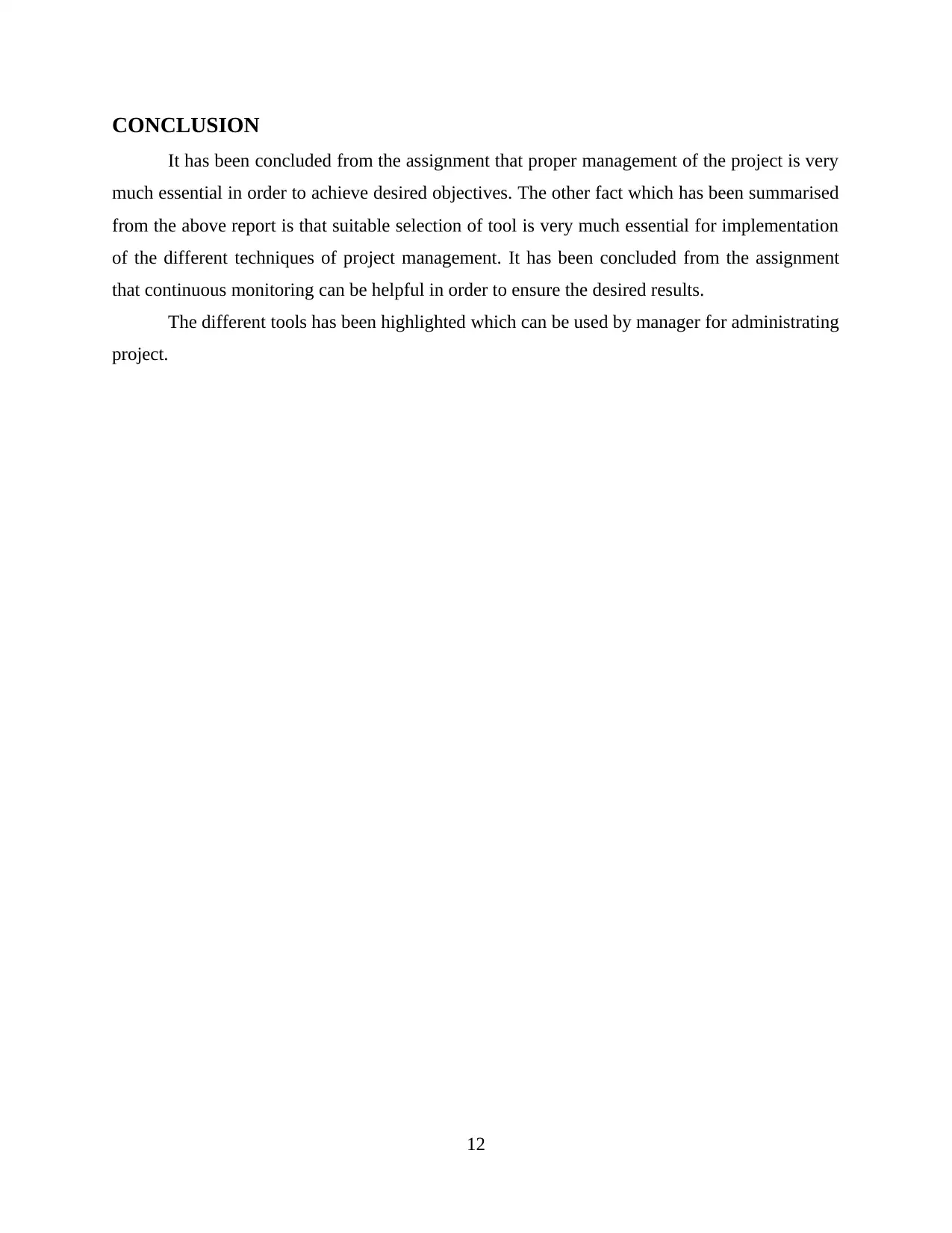
CONCLUSION
It has been concluded from the assignment that proper management of the project is very
much essential in order to achieve desired objectives. The other fact which has been summarised
from the above report is that suitable selection of tool is very much essential for implementation
of the different techniques of project management. It has been concluded from the assignment
that continuous monitoring can be helpful in order to ensure the desired results.
The different tools has been highlighted which can be used by manager for administrating
project.
12
It has been concluded from the assignment that proper management of the project is very
much essential in order to achieve desired objectives. The other fact which has been summarised
from the above report is that suitable selection of tool is very much essential for implementation
of the different techniques of project management. It has been concluded from the assignment
that continuous monitoring can be helpful in order to ensure the desired results.
The different tools has been highlighted which can be used by manager for administrating
project.
12
⊘ This is a preview!⊘
Do you want full access?
Subscribe today to unlock all pages.

Trusted by 1+ million students worldwide
1 out of 13